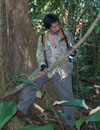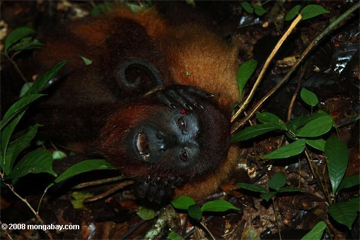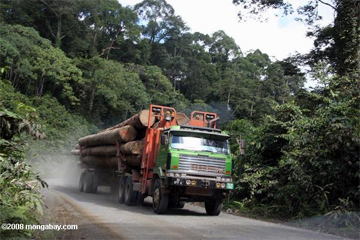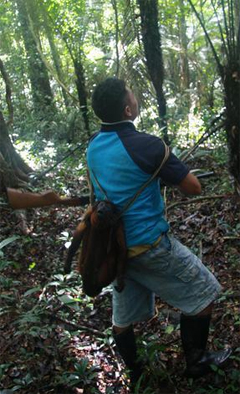Commercial bushmeat trade is devastating wildlife
Commercial bushmeat trade is devastating wildlife
mongabay.com
September 15, 2008
|
|
Commercial killing of rainforest wildlife is putting biodiversity at risk and reducing sources of protein for rural populations, warns a new report from the Center for International Forestry Research (CIFOR) and the Secretariat of the Convention on Biological Diversity (CDB).
The report — which assessed the sustainability of bushmeat hunting — estimates that more than a million tons of bushmeat are harvested from Central Africa each year, an amount equivalent of almost four million head of cattle. It notes that while bushmeat provides up to 80 percent of the protein and fat needed in rural diets in Central Africa, policy makers pay little heed to managing the resource. As such, wildlife is being rapidly depleted in parts of the region both by local consumers who rely on game meat for protein and commercial hunters who sell to urban markets domestically and abroad.
“If current levels of hunting persist in Central Africa, bush meat protein supplies will fall dramatically, and a significant number of forest mammals will become extinct in less than 50 years,” said Robert Nasi of CIFOR, an author of the report.
|
|
The report says that while bushmeat hunting is decimating wildlife, the practice should be regulated rather than banned outright. A ban on bushmeat would only serve to impoverish rural populations dependent on game for protein and drive the practice further underground, the report argues.
“If local people are guaranteed the benefits of sustainable land use and hunting practices, they will be willing to invest in sound management and negotiate selective hunting regimes,” said Frances Seymour, Director General of CIFOR. “Sustainable management of bushmeat resources requires bringing the sector out into the open, removing the stigma of illegality, and including wild meat consumption in national statistics and planning.”
The report, “Conservation and Use of Wildlife-Based Resources: The Bushmeat Crisis,” argues that since the industrial extractive sector — logging, mining, and drilling — facilitates the bushmeat trade through the construction of roads and even the direct hiring of hunters to provision workers, it should play an important role in improving the sustainability of game harvesting. It recommends that these industries to work with stakeholders to “develop forest policies and management plans that incorporate wildlife concerns, rather than focusing just on timber and other forms of natural resource extraction,” according to a statement released by CIFOR.
|
|
“Such plans should include conservation education, an agreed system of law enforcement, development of alternative protein supplies and an intensive monitoring program,” the statement continues. “If designed and applied appropriately, this will not only serve to enhance wildlife conservation, but will ultimately benefit the private sector and local communities as well.”
The report suggests that Western consumers could play a hand in the effort since it is their demand for wood products that helps drive logging.
The report also recommends establishing clear title to land in forest areas.
“Only if the local hunter is bestowed with some right to decide what, where and how he may hunt — as well as the knowledge to understand the consequences of his decisions — will he embrace his responsibility to hunt sustainably,” Nasi said.
Some notes from the report
- In Gabon, the annual bushmeat trade has been valued at US$25 million (€18.5 million), while in West and Central Africa, estimates range from $42 to $205 per year. The current annual harvest in Central Africa alone may be in excess of 2 million metric tons, the equivalent of over 1.3 billion chickens or 2.5 million cows.
- The value of wild meat harvested in the Amazon basin exceeds $175 million per year.
- In at least 62 countries world-wide, wildlife and fish constitute a minimum of 20% of the animal protein in rural diets. Hunting provides between 30% and 80% of the overall protein intake of rural households in Central Africa.
- The overall international trade in animal products is estimated at approximately US$3.9 billion.
CITATION: Nasi, R.; Brown, D.; Wilkie, D.; Bennett, E.; Tutin, C.; van Tol, G.; Christophersen, T. 2007. Conservation and Use of Wildlife-Based Resources: The Bushmeat Crisis [PDF]. Secretariat of the Convention on Biological Diversity, Montreal, and Center for International Forestry Research (CIFOR), Bogor. Technical Series no. 33, 50 pages.
Related articles
Bushmeat trade “most significant” threat to Africa’s wildlife says Richard Leakey
(09/25/2008) Maverick conservationist, Richard Leakey, writes that “commercial bushmeat hunting has become the most significant immediate threat to the future of wildlife in Africa and around the world” in an article on Wildlife Direct. Founded by Leakey, Wildlife Direct is a nonprofit allowing researchers and wildlife organizations in Africa and Asia to connect directly with supporters through blogs.
 |
Subtle threats could ruin the Amazon rainforest
(11/7/2007) While the mention of Amazon destruction usually conjures up images of vast stretches of felled and burned rainforest trees, cattle ranches, and vast soybean farms, some of the biggest threats to the Amazon rainforest are barely perceptible from above. Selective logging — which opens up the forest canopy and allows winds and sunlight to dry leaf litter on the forest floor — and 6-inch high “surface” fires are turning parts of the Amazon into a tinderbox, putting the world’s largest rainforest at risk of ever-more severe forest fires. At the same time, market-driven hunting is impoverishing some areas of seed dispersers and predators, making it more difficult for forests to recover. Climate change — an its forecast impacts on the Amazon basin — further looms large over the horizon.
 |
Defaunation, like deforestation, threatens global biodiversity
(5/20/2008) Loss of wildlife is a subtle but growing threat to tropical forests, says a leading plant ecologist from Stanford University. Speaking in an interview with mongabay.com, Dr. Rodolfo Dirzo says that the disappearance of wildlife due to overexploitation, fragmentation, and habitat degradation is causing ecological changes in some of the world’s most biodiverse tropical forests. He ranks defaunation — as he terms the ongoing biological impoverishment of forests — as one of the world’s most significant global changes, on par with environmental changes like global warming, deforestation, and shifts in the nitrogen cycle.
 |
Commercial hunting may be biggest threat to tropical rainforests
(5/1/2007) Commercial hunting is decimating wildlife populations across the tropics and may be one of the gravest threats presently facing rainforests, reports a series of studies published in the May issue of the journal Biotropica. The research reveals that large-scale loss of wildlife is already affecting forest health and regeneration.
Bushmeat from African apes sold in American markets
(7/6/2006) Bushmeat from wild primates in Africa is ending up on plates in North America and western Europe according to an article published in the current issue of New Scientist. Justin Brashares, a wildlife biologist at the University of California at Berkeley who carried out a survey of clandestine markets in seven major cities, says that the meat, which includes chimpanzee and gorilla parts, makes up nearly a third of the illegal international trade in bushmeat killed in Africa.
Roads tied to bushmeat hunting in Africa
(5/9/2006) A new study ties the presence of roads to bushmeat hunting in the Congo rainforest and also raises important questions on global conservation approaches. The study, published in the current edition of conservation Biology, found roads and associated hunting pressure reduced the abundance of a number of mammal species including duikers, forest elephants, buffalo, red river hogs, lowland gorillas and carnivores. The research suggests that even moderate hunting pressure can significantly affect the structure of mammal communities in central Africa.


